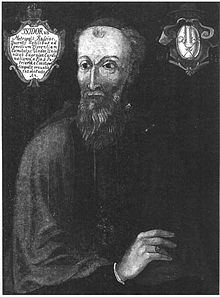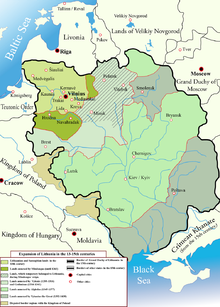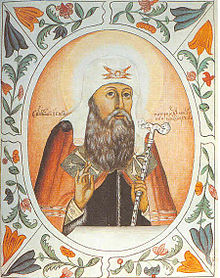Metropolis of Moscow and all Russia
The Metropolis of Moscow and all Russia was a
Background


An
Following the signing of the
Establishment

After the metropolitan throne lay vacant for seven years, the secular authorities replaced him with the Bishop of Ryazan and Murom — Jonah of Moscow. Like his immediate predecessors, he permanently resided in Moscow, and was the last Moscow-based primate of the metropolis to keep the traditional title with reference to the metropolitan city of Kiev. He was also the first metropolitan in Moscow to be appointed without the approval of the Ecumenical Patriarch of Constantinople as had been the norm.[1] This signified the beginning of the de facto independence (autocephaly) of the Moscow (north-eastern) part of the Church.
The struggle for ecumenical union at Ferrara and Florence, while promising, never bore fruit. While progress toward union in the East continued to be made in the following decades, all hopes for a proximate reconciliation were dashed with the fall of Constantinople in 1453. Following their conquest, the Ottomans encouraged hardline anti-unionist Orthodox clerics in order to divide European Christians.[10] Afterwards, the Church in Russia and the Russian state came to regard saw Moscow as the "Third Rome" and as the sole, legitimate successor to Constantinople.
Notwithstanding these events, the Ecumenical Patriarch continued to appoint metropolitans for the united Catholic and Eastern Orthodox ("
Ecclesiastical structure

Jonah was unable to exercise any pastoral control beyond the borders of Muscovy. In the lands of the Grand Duchy of Lithuania and the Kingdom of Poland, the rulers rejected Jonah and continued to recognise Isidore as metropolitan. The metropolis was effectively split in two; Jonah ruled from Moscow in the east while Isidore and his successors ruled the western part from Novogrudok. Dioceses:
- Urban Diocese of Moscow
- Diocese of Novgorod
- Diocese of Rostov
- Diocese of Yaroslavl
- Diocese of Smolensk
- Diocese of Kazan
- Diocese of Saratov
- Diocese of Tver
- Diocese of Vladimir
Changes and reforms
The reign of
Monastic life flourished, with two major strands co-existing until the definitive defeat of the
In the 1540s,
Disestablishment

When traveling across eastern Europe from 1588 to 1589, Patriarch Jeremias II of Constantinople visited Moscow. He confirmed the de facto autocephaly of the Eastern Orthodox Church in Russia. For the first time since 1448, an Ecumenical Patriarch consecrated a metropolitan in Rus' lands — Job of Moscow. At the same time, in raising the metropolis to a patriarchate — as the Patriarchate of Moscow and all Rus' — he effectively disestablished the metropolis. The Patriarchate was abolished by the Church reform of Peter the Great in 1721 and replaced by the Most Holy Synod, and the Bishop of Moscow came to be called a Metropolitan again.
Notes
- ISBN 1610488938(page 10).)
- ^ Sometimes also spelled as Laetentur Coeli, Laetantur Caeli, Lætentur Cæli, Lætentur Cœli, or Lætantur Cæli, and occasionally referred to as the Act of Union or "Decree of Union".
References
- ^ a b E. E. Golubinskii, Istoriia russkoi tserkvi (Moscow: Universitetskaia tipografiia, 1900), vol. 2, pt. 1, p. 469.
- ^ Bainton, Roland H. (1966), Christendom: A Short History of Christianity, vol. I, New York: Harper & Row, p. 119
- ^ a b Valois, 1911, pg463
- ^ Joseph Gill, Personalities of the Council of Florence, pg68
- ^ "Bulla Laetentur caeli (6 Iul. 1439), de unione Graecorum". www.vatican.va. Retrieved 27 December 2022.
- ^ Dezhnyuk, Sergey. "COUNCIL OF FLORENCE: THE UNREALIZED UNION". Retrieved 27 December 2022 – via www.academia.edu.
- ^ Matthew R. Lootens, "Silvestros Syropoulos", in Graeme Dunphy and Cristian Bratu (eds.), Encyclopedia of the Medieval Chronicle (published online 2016), accessed 21 September 2017.
- ^ a b "The Cardinals of the Holy Roman Church - Consistory of December 18, 1439". cardinals.fiu.edu. Retrieved 14 March 2022.
- ^ ИОНА // Orthodox Encyclopedia
- ^ "Lessons for Theresa May and the EU from 15th-century Florence". The Economist. 24 September 2017.
- ^ a b Slocombe, G. Poland. T. C. & E. C. Jack. 1916
- ^ a b FRICK, D.A. Meletij Smotryc'kyj and the Ruthenian Question in the Early Seventeenth Century. Harvard Ukrainian Research Institute. 1984
- ^ Frost, R.I. The Oxford History of Poland-Lithuania: The Making of the Polish-Lithuanian Union, 1385–1569. Oxford University Press, 2015
